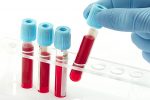Blood NfL Levels May Mark SMA Severity, Therapy Efficacy in Very Young

Blood levels of neurofilament light chain (NfL) — a marker of nerve cell damage — in children and adolescents with spinal muscular atrophy (SMA) are significantly higher than those of age-matched healthy peers and associate with disease severity, a study found.
NfL blood levels also reliably reflect levels in the cerebrospinal fluid (CSF), and show a potential to serve as a treatment response biomarker in infants with SMA type 1, and in toddlers with milder disease forms up to age 3. (CSF is the liquid that bathes the brain and spinal cord.)
Larger studies are needed to confirm these findings and to better understand whether the smaller NfL differences seen between older children with milder SMA and healthy individuals reflect a milder or a more minor role of neurodegeneration at later stages, and a missed window of opportunity for current disease-modifying therapies, the researchers noted.
The study, “Serum neurofilament light chain in pediatric spinal muscular atrophy patients and healthy children,” was published in the journal Annals of Clinical and Translational Neurology.
SMA is caused by no to low levels of SMN, a protein essential for motor neuron muscle health, due to mutations in the SMN1 gene.
The number of copies of the SMN2 gene, which can partly compensate for the loss of the SMN protein produced by SMN1, influences SMA severity. Typically, the more SMN2 copies a patient has, the less severe is the disease.
Major structural proteins of neurons, neurofilaments are released into the CSF and bloodstream when nerve cell fibers are damaged and neurons die.
Consisting of three major subunits (heavy, intermediate, and light chains), neurofilament CSF and blood levels have been studied and used as potential biomarkers of nerve cell damage and death in several neurodegenerative conditions, including SMA.
However, evidence is still limited on their potential as a diagnostic and monitoring biomarker across SMA types and patients’ age groups, as well as on whether blood NfL levels reflect changes in the CSF.
A team of researchers at Technische Universität Dresden, in Germany, analyzed NfL levels in the blood and CSF of 18 children and adolescents with SMA (ages ranging from 18 days to 17.2 years), carrying varying numbers of SMN2 copies, before and after the administration of Biogen’s SMN-boosting therapy Spinraza (nusinersen) over nearly three years.
They also analyzed potential associations between NfL levels and patients’ features and motor development, as assessed with validated and age-appropriate measures.
Blood NfL levels in 97 age-matched neurologically healthy children were also assessed to establish pediatric reference values for future studies in SMA and other neurodegenerative diseases.
Of the 18 SMA patients analyzed, four (22%) carried two SMN2 copies and had a median age of 2.8 months (range: 18 days–11.1 months), and 14 children (78%) had more than two SMN2 copies and a median age of 8.4 years (range: 1.1–17.2 years).
Of note, SMA patients with two SMN2 copies — the same number as in healthy individuals — will likely develop type 1, a severe form, while the presence of more than two SMN2 copies is suggestive of relatively milder forms, such as types 2 and 3.
Results showed that, among neurologically healthy children and adolescents, median blood NfL levels did not differ between sexes, but were significantly higher in children up to age 4, compared with those older than 4.
This age-dependent trajectory is consistent with data from previous studies, and may reflect nerve cell death “as part of neuronal network reconfigurations” within the developing brain and spinal cord, the researchers wrote.
Compared with this healthy population, SMA children had significantly higher blood NfL levels — by 50 times among infants likely to have type 1 disease, and by two times in children and adolescents with milder disease forms.
A strong association was seen between NfL levels in the blood and the CSF of all SMA patients, and children with more severe disease showed significantly higher NfL levels than those with milder SMA.
Spinraza treatment in children with likely type 1 disease resulted in a NfL level drop — detected in the CSF after the first dose and in the blood after the second — and in a steady improvement in motor function, with a strong link between the two.
Notably, NfL levels in Spinranza-treated infants with severe SMA approached those seen in age-matched healthy children, but remained about three times higher.
No such association was found for children with milder forms of SMA, who showed generally closer NfL levels to those in age-matched healthy individuals, and no major changes in neurofilament levels and motor function scores were evident with Spinraza’s use.
The only exception was the youngest child with milder SMA, who carried three SMN2 copies (suggestive of type 2 disease) and started treatment at 1 year of age. The boy showed considerably higher NfL levels compared with the other milder SMA patients, and a strong association between NfL levels and motor improvements during treatment.
The next youngest child in this group was more than 3 years old, and showed no similar associations, suggesting that NfL levels may be used as a treatment response biomarker for patients under age 3.
“We, therefore, hypothesize whether the age at the initiation of treatment is an even more decisive determinant of future changes in NfL and motor function achievements than the SMN2 copy number,” the researchers wrote.
Overall, the findings highlight that blood NfL levels “may be a suitable biomarker for disease activity in children with 2 SMN2 copies and those with [more than two] SMN2 copies within their initial stages during early childhood,” the team wrote.
“A less invasive route of sampling, particularly in childhood, that is collection of blood, is desirable for an ideal biomarker of neuronal damage,” they added.
NfL and SMN protein levels are potential complementary SMA biomarker candidates of disease activity and treatment efficacy, “with SMN protein count as specific positive verification of efficient therapeutic upregulation and NfL as a negative indicator of ongoing [nerve fiber] injury,” the researchers wrote.
Results seen in children, 3 years and older, with milder forms of SMA also suggest that “in later stages of SMA the [disease-associated] process of neurodegeneration may be marginal or play a minor role than previously anticipated,” the team wrote.
“This hypothesis, together with the question of whether [blood NfL level] elevations could delineate a critical window of susceptibility for effective SMN-modifying interventions, encourage further investigation,” they concluded.








